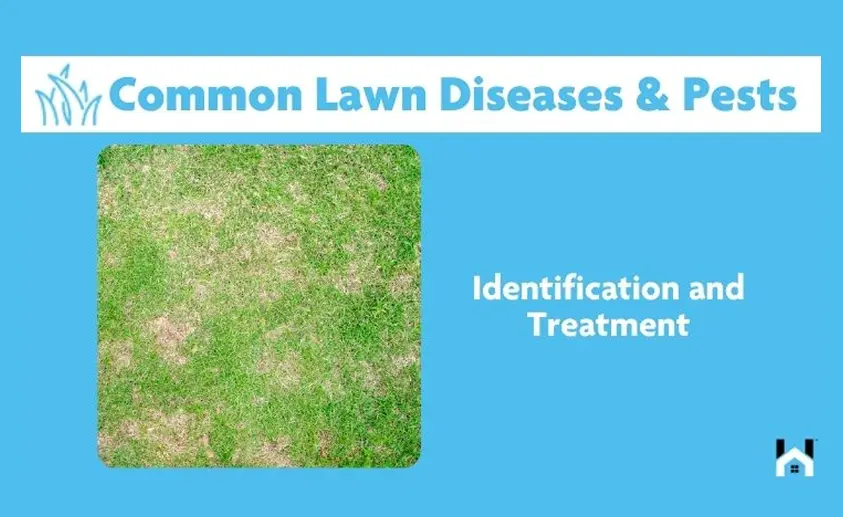Common Lawn Diseases and Pests: Identification and Treatment

Maintaining a lush, vibrant lawn can indeed be a fulfilling pursuit, although it often presents certain challenges.
Your grass may encounter various threats, ranging from unsightly brown patches to bothersome pests, which can impede its overall health and beauty. It is crucial to understand the different types of lawn diseases and pests to effectively prevent and treat these issues.
This guide aims to assist you in identifying symptoms, implementing sound care practices, and addressing specific problems with targeted treatments. By following these recommendations, you can learn how to keep your lawn thriving and resilient against these common threats.
Types of Diseases and Pests that Affect Lawns
Understanding the different types of diseases and pests that can affect your lawn is essential for maintaining its health and appearance. From fungal infections like brown patch and dollar spot to pests such as chinch bugs and grubs, each presents its own set of challenges.
Early identification of these issues can significantly enhance your lawn care efforts. Additionally, it's important to recognize that various grass types may exhibit different levels of resistance to diseases, so knowing what to look for in your specific turf variety is crucial.
Identifying and Diagnosing Lawn Diseases and Pests
Effective lawn care starts with the skill to accurately identify and diagnose lawn diseases and pests. By recognizing symptoms such as discoloration, wilting, or unusual spots on the foliage, you can differentiate between various issues.
Conducting a thorough visual inspection often serves as your first line of defense, enabling you to observe any signs of pest infestation or fungal infections that may be affecting your grass types.
Signs and Symptoms to Look Out For
Understanding the signs and symptoms of lawn diseases and pests is crucial for early detection and intervention. Symptoms such as leaf spots, brown patches, and rust can indicate the presence of fungal infections, while the discovery of grubs or armyworms may point to pest problems.
Familiarity with the life cycles of these diseases and pests can also provide valuable insights into when these issues are likely to arise, enabling homeowners to implement timely preventive measures.
For instance, root rot commonly presents as wilting or discolored grass, which could signal deeper issues related to soil drainage or excessive moisture. Additionally, thatch buildup poses another challenge, as it can become a breeding ground for pests and diseases if it accumulates too thickly. By recognizing these specific signs, homeowners can take proactive steps to address the underlying problems.
Moreover, integrating knowledge of seasonal patterns can enable homeowners to anticipate when certain diseases or pests may emerge, ultimately contributing to a healthier and more resilient lawn.
Preventing Lawn Diseases and Pests
Preventing lawn diseases and pests is generally more effective than addressing them once they have taken hold. By implementing sound lawn care practices—such as proper watering, aeration, and soil amendments—you can significantly enhance your lawn's resilience.
Maintaining good soil health through regular testing and the use of organic treatments is crucial for disease prevention. Additionally, adopting cultural practices can help reduce the likelihood of pest invasions, ensuring a healthier and more vibrant lawn overall.
Treating Lawn Diseases and Pests
When addressing lawn diseases and pests, there are several methods available to restore the health and vitality of your turf. You can utilize fungicides to tackle fungal infections, such as powdery mildew and rust.
Insecticides can also be employed to manage pests like white grubs and cutworms. It is important to understand the various options at your disposal.
Furthermore, considering organic treatments can provide eco-friendly alternatives that may align better with sustainable lawn care practices.
Dealing with Specific Types of Lawn Diseases and Pests
Each type of lawn disease and pest necessitates a customized approach for identification and treatment to achieve the best results. For example, identifying the symptoms of brown patch or dollar spot early on can significantly enhance recovery strategies.
Likewise, effectively managing specific pests such as chinch bugs or grubs requires an understanding of their life cycles, which in turn allows for the implementation of the most effective pest control measures.
Identification and Treatment for Each Type
Identifying and addressing specific lawn diseases and pests necessitates a thorough understanding of the characteristics associated with each issue. For instance, recognizing signs of root rot or leaf spot can direct you to the appropriate treatment methods, such as applying a fungicide or adjusting your watering practices. Similarly, knowing how to identify pests like armyworms or cutworms enables timely intervention and the implementation of effective pest control strategies.
Beyond identification, it is essential to comprehend the conditions that foster these problems, as this knowledge significantly contributes to management efforts. Case studies have indicated that lawns affected by brown patches often experience issues due to excessive moisture or inadequate soil aeration, while those with pest infestations typically suffer from weakened grass caused by nutrient deficiencies.
Customized treatment options may involve targeted fertilization or the practice of crop rotation to disrupt pest life cycles. Additionally, recovery strategies such as overseeding with disease-resistant varieties can assist in restoring lawn health.
Integrated pest management is emerging as a crucial approach, as it combines cultural practices, biological controls, and judicious chemical applications to ensure sustainable lawn maintenance.
Effective Lawn Care Practices
Implementing effective lawn care practices is essential for maintaining a healthy and resilient lawn capable of withstanding potential diseases and pests. Regular activities such as aeration, proper fertilization, and adhering to an appropriate watering schedule can significantly enhance the overall health of your turf. Additionally, adopting cultural practices that promote microbial activity and soil health can contribute to disease resistance and improve lawn quality.
For example, aeration can help alleviate soil compaction, allowing air, water, and nutrients to penetrate the root zone more effectively. It is advisable to aerate during the growing season to ensure optimal recovery. Fertilization is equally important; using a slow-release fertilizer that is tailored to the local climate can provide essential nutrients without overwhelming the grass. Maintaining a consistent watering routine—ideally in the early morning to minimize evaporation—is fundamental to keeping the lawn hydrated without risking waterlogging.
Engaging in seasonal care, such as overseeding in the fall or spring, can also ensure a dense turf that is better equipped to outcompete weeds and pests. By incorporating these practices, homeowners can cultivate a vibrant lawn that flourishes throughout the changing seasons.
Common Treatment Methods
Common treatment methods for lawn diseases and pests can vary significantly based on the specific issue being addressed. For example, using fungicides is crucial for managing severe fungal infections, while insecticides are effective in targeting harmful pests such as white grubs and chinch bugs. By understanding both chemical and organic treatment options, one can select the most appropriate approach for maintaining the health and sustainability of their lawn.
Plus these direct interventions, implementing cultural practices such as proper watering, mowing, and fertilization can enhance a lawn's resilience against diseases and pests. Encouraging natural predators by improving their habitats can notably reduce pest populations without resorting to chemical pesticides.
While synthetic treatments may provide quick relief, they also carry potential risks to non-target species and the surrounding environment.
Thus, a thoughtful combination of both organic and chemical solutions, applied with care and in accordance with established guidelines, can effectively support the maintenance of a vibrant and ecologically balanced lawn.

Need help with
your project?
Whether you’re planning a project or just trying to remember when to clean your gutters, we’ve got your back (and your inbox).



